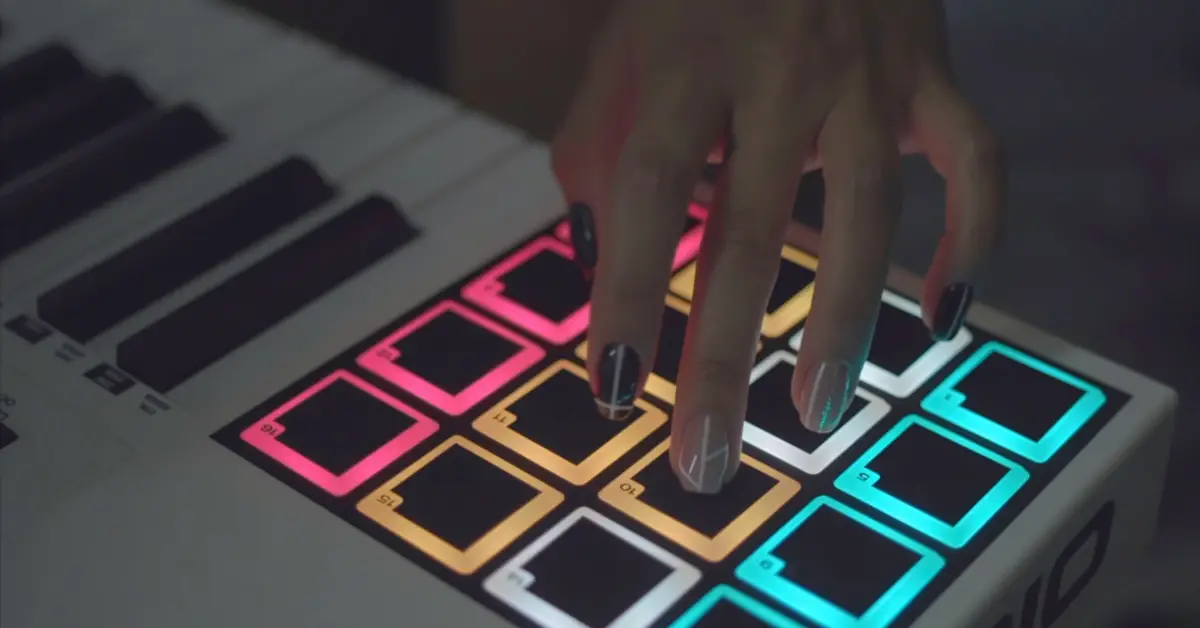
Hey beat makers! Ever dreamt of creating killer rhythms that pump up your music? Look no further, because this guide is about to be your best friend. We'll break down the best drum machines of 2024, from budget-friendly options to feature-packed beasts. So, get ready to find the perfect machine to take your beats to a new level!
Included in this guide:
| Image | Product | Features | Price |
|---|---|---|---|
Best Overall  | AKAI Professional MPC One+ Drum Machine
| 4.6 | Check Price |
Runner-up  | Roland TR-6S Compact Drum Machine
| 4.7 | Check Price |
Top Pick  | Novation Circuit Tracks Groovebox
| 4.5 | Check Price |
Top Pick  |
| 4.5 | Check Price |
Lowest Price  | Korg Volca Drum Physical Modeling Drum Synthesizer
| 4.6 | Check Price |
Related Article: Panning Drums: How To Create The Perfect Space In A Mix
AKAI put a lot of focus on usability and premium feel while designing the Music Production Center (MPC) One+ standalone sample/sequencer. The result was a feature-rich machine with Bluetooth support, 16GB internal storage, a multi-core processor, CV/gate outs, and a 7” full-color multi-gesture touchscreen—all wrapped up in a hot-red chassis.
The connectivity, in particular, will come in handy when you try to access any of the plug-ins on the AKAI platform. On the older MPC model, you had no choice but to use an Ethernet cable—not on the WiFi-enabled One+ drum machine, though.
Roland’s digital TR-6S drum machine and audio interface runs on an Analog Circuit Behavior (ACB) engine modeled after the circuitry in the iconic TR-X0X beatboxes—from the TR-606 and all the way to the TR-909. It even carries a hint of the vintage CR-78 CompuRhythm and the TR-727.
The pads don’t take up much space on the top panel. Neither does the screen, which is fairly small but also perfectly legible. Instead, the TR-6S has the layout of a mixer, with dedicated channels and sliding faders for each of the six drum parts (bass, snare, low tom, clap, and closed/open hi-hat). Labels aside, you could load any instrument to those channels.
The Circuit Tracks Groovebox is a highly portable, battery-powered, standalone machine with two onboard synths (running on Nova-series engines), four independent sample-based drum tracks, and two MIDI tracks all on a 4x8 matrix. To make room for the matrix, Novation opted for a screenless design. But that’s not a major flaw since the pads are accessible and not fiddly.
Unlike the original Novation Circuit model, the new Circuit Tracks has a large onboard memory to hold 64 active projects per pack. The Groovebox can only hold one pack (a full memory state of presets, projects, and sequences) at a time, though. The workaround is to use a micro SD slot for storing 30+ packs.
Alesis upgraded the sound engine on their SR-16 programmable drum machine from 16 bits to 24 bits to curb the noise. However, the machine still retains the same stripped-back panel layout, with a huge volume knob, split-view display, and rubbery pads. That said, these pads only give you access to a small part of the available sounds and only eight loudness levels. The 127 velocity responses are accessible via MIDI.
The Volca Drum box runs on a six-part DSP engine, where each part is dual-layered. Users start with a basic waveform trigger (sine wave, sawtooth wave, HPF noise, etc.) that they can then fold, overdrive, and distort. Both layers can be edited simultaneously (to thicken the sound up) or individually to control the output as needed. The result is an engine that sounds so unlike conventional drum machines.
Related Article: The 7 Best MIDI Controllers Of 2024 To Create Music With
A few models support wireless connectivity options (WiFi or Bluetooth). But even without those features, drum machines can easily be integrated into your setup with USB or MIDI ports. You might need to change the timing settings on your DAW, though.
Yes, many models can run just fine without a DAW. They have their own controls, pre-loaded sounds, and maybe even built-in batteries. However, it would be hard to call them truly “self-contained” when most models don’t have built-in speakers.
Drum machine engines can be analog (or virtual analog), FM synthesizers, or sample-based. Many manufacturers will mix and match operation modes to make their engines more versatile. Most will also allow you to load up your own samples via SD card or USB.
Some musicians and producers find that screenless designs make the pads more accessible and the interface less distracting. Others steer away from screenless machines, believing they’re harder to control. Ultimately, it all depends on whether you think a display (touch or otherwise) will benefit your workflow.
Drum machines are very closely associated with hip-hop and electronic music. After all, vintage X0X models like the TR-909 and TR-808 have had a huge impact on these genres. However, you can still use drum machines to add flare to indie, pop, and R&B tracks.
With a sizable touch display, wireless connectivity options, and a powerful sampler, it’s easy to see why the MPC One+ is a premium pick. The TR-6S might not look as cool and edgy, but its ACB engine still does a fantastic job of simulating analog originals—imperfections and all. But of all the machines we reviewed, Volca Drum proved to be the most unexpected in its dual-layered structure, unique sounds, and affordable price point.
If you found this guide helpful, please consider subscribing to our blog for more music production tips, product reviews, and buying guides. Also, you can support new content by contributing to our tip jar.
"Some of the links within this article are affiliate links. These links are from various companies such as Amazon. This means if you click on any of these links and purchase the item or service, I will receive an affiliate commission. This is at no cost to you and the money gets invested back into Audio Sorcerer LLC."